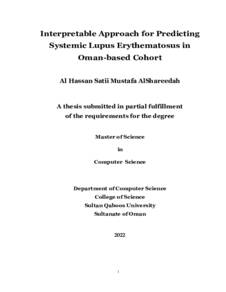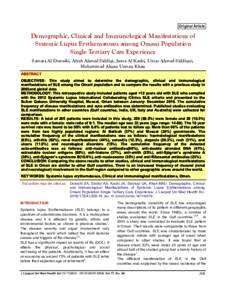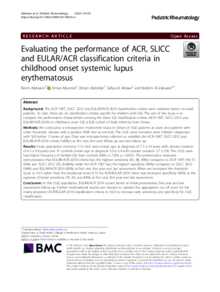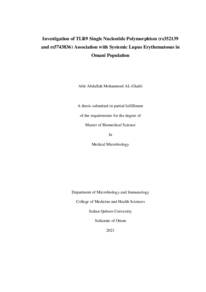Document
Interpretable approach for predicting systemic lupus erythematosus in Oman-based cohort.
Other titles
اتباع المنهج التفسيري لبناء منظومة في منظومة لتوقع داء الذئبة الحمراء على شريحة من المرضى العمانيين
Publisher
Sultan Qaboos University.
Gregorian
2022
Language
English
English abstract
Background: Systemic Lupus Erythematosus (SLE) is a multi-systemic
autoimmune disease linked to significant morbidity and mortality. Multiple
challenges are found in the diagnosis of SLE, due to overlap with other autoimmune
pathologies, in addition to wide variation in disease manifestation across racial and
ethnic groups. Thus diagnosis can be delayed by several months or years, which
carries the risk of progressive organ damage. Currently, the mortality rate of SLE in
Oman is estimated at 5%. Once diagnosed, physicians set up a treatment plan to
control symptoms as there is currently no cure. Improving early diagnosis of SLE
will lead to lower flare rates and better healthcare outcomes.
Despite previous research indicating several characteristics that are unique to the
Arab region, publications that are unique to Oman population are scarce.
Aims: (a) Design an early-prediction explainable framework to detect the presence
or absence of SLE, (b) Identify the minimum set of clinical features that achieves
the highest prediction, and (c) leverage interpretability method to explain the
predictions for physicians.
Methods: From a dataset of randomly selected 219 patients with SLE or control
rheumatologic diseases, clinical and demographic features were analyzed to focus
on early stages of the disease. Several feature selection algorithms and classifiers
were applied to identify the best performing combination. SHAP explainer
algorithm was then applied on the best achieving model to justify individual
predictions and rank features based on contribution.
Results: A combination of Recursive Feature Elimination (RFE) and CatBoost
achieved the best performance, an AUC score of 0.95 and an F1-score of 0.89 with
only 13 clinical features. Four clinical features (alopecia, renal, ACL, and hemolytic
vii
anemia) along with the patient's age were shown to have the greatest contribution
to the prediction by SHAP algorithm.
Our system was able to pick up on patterns of specific features and age groups that
are associated with the disease. This will help physicians to further investigate SLE
presence within a patient at early stages where symptoms are not yet adverse.
Moreover, three of the four critical features were found to persist across other Arab
cohorts. Additional validation by experts shows the potential of the generalizing
model to other Arab ethnicities as well.
Member of
Resource URL
Arabic abstract
يعرف داء الذئبة الحمراء بأنه مرض ذاتي مناعي غير معدي يحدث في مختلف الاعمار، ى ويتباين من شخص لآخر في الشدة. أعراض المرض متنوعه من طفح جلدي في الوجه تساقط شعر فروة الرأس إلى أضرار عضوية في الكبد والرئتين والجهاز العصبي.
Category
Theses and Dissertations






